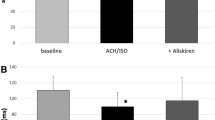Abstract
Background: There is evidence suggesting that atrial fibrillation (AF) may be induced by acute increase of atrial pressure. The aim of the present study was to investigate the effect of alterations in atrial pressure, induced by varying the atrioventricular (AV) interval, on atrial refractoriness, and on the frequency of induction of (AF), in patients with a history of lone atrial fibrillation (LAF).
Methods and Results: Twenty-five patients were included in this study. The patients were divided in two groups: the LAF group, and the control group. None of the patients in either group had organic heart disease. Effective refractory period (ERP) and duration of atrial extrastimulus electrogram (A2) were measured at two right atrial sites (high lateral wall, atrial appendage) during AV pacing (cycle length: 500 msec) with different AV intervals. Peak, minimal and mean atrial pressure increased from 8.57 ± 2.37 to 18.14 ± 4.74 mm Hg, 2 ± 2.23 to 5.14 ± 2.60 mm Hg (p = 0.0001) and from 4.28 ± 1.6 mm Hg to 9.77 ± 2.9 mm Hg (p = 0.001), respectively during AV interval modification. During lateral and atrial appendage pacing, with a progressive decrease of AV interval to 160, 100, 80, 40, 0 msec, the ERP, the dispersion of ERP, functional refractory period (FRP), A2 and latency period (LP) did not change significantly, in both groups. The frequency of induction of AF was not statistically different in both lateral atrial wall and appendage, during pacing in different AV intervals.
Conclusions: This study demonstrates that alterations in the intraatrial pressure does not have important effects on atrial refractoriness and does not increase vulnerability to AF in patients with a history of LAF.
Similar content being viewed by others
References
Lerman BB, Burkhoff D, Yue DT, Sagawa K. Mechanoelectrical feedback: Independent role of preload and contractility in modulation of canine ventricular excitability. J Clin Invest 1982;76:1843–1850.
Lakatta EG. Starling' law of the heart is explained by an intimate interaction of muscle length and myofilament calcium activation. J Am Coll Cardiol 1987;10:1157–1164.
Lee KS, Marban E, Tsien RW. Inactivation of calcium channels in mammalian heart cells: Joint dependence on membrane potential and intracellular calcium. J Physiol 1985;354:395–411.
Di Francesco D, Mc Naughton DA. The effects of calcium on outward membrane currents on the cardiac Purkinje fibre. J Physiol 1979;289:347–373.
Kaseda S, Zipes DP. Contraction-excitation feedback in the atria: A cause of changes in refractoriness. J Am Coll Cardiol 1988;11:1327–1336.
Klein LS, Miles WM, Zipes DP. Effect of atrioventricular interval during pacing or reciprocating tachycardia on atrial size, pressure, and refractory period. Contraction-excitation feedback in human atrium. Circulation 1990;82:60–68.
Jajal S, Williams GR, Mann DE, Reiter MJ. Effect of acute ventricular dilatation on fibrillation thresholds in the isolated rabbit heart. Am J Physiol 1992;263:H1306–1310.
Smeets JL, Allessie MA, Lammers WJ, Bonne FIH, Hollen J. The wavelength of the cardiac impulse and reentrant arrhythmias in isolated rabbit atrium. The role of the heart rate, autonomic transmitters, temperature, and potassium. Circ Res 1986;58:96–108.
Allessie MA, Rensma PL, Lammers WJEP, Kirchoff CJHJ. The role of refractoriness, conduction velocity, and wavelength in initiation of atrial fibrillation in normal conscious dogs. In: Attuel P, Coumel P, Janse MJ. The Atrium in Health and Disease. Mount Kisco, NY: Future Publishing Co, 1989:271–274.
Calkins H, El-Atassi R, Leon A, Kalbfleisch S, Borganelli M, Langberg J, Morady F. Effect of the atrioventricular relationship on atrial refractoriness in humans. PACE. 1992;15:771–778.
Calkins H, El-Atassi R, Kalbfleisch S, Langberg J, Morady F. Effects of an acute increase in atrial pressure on atrial refractoriness in humans. PACE. 1992;15:1674–1680.
Ellenbogen KA, Stambler BS, Wood MA, Mohanty PK. Examination of mechano-electrical feedback in the transplanted human heart. Am J Card 1995;76:51–55.
Ravelli F, Allessie M. Effects of atrial dilatation on refractory period and vulnerability to atrial fibrillation in the isolated Langendorf-perfused rabbit heart. Circulation 1997;96:1686–1695
Author information
Authors and Affiliations
Rights and permissions
About this article
Cite this article
Efremidis, M., Sideris, A., Prappa, E. et al. Effect of Atrial Pressure Increase on Effective Refractory Period and Vulnerability to Atrial Fibrillation in Patients with Lone Atrial Fibrillation. J Interv Card Electrophysiol 3, 307–310 (1999). https://doi.org/10.1023/A:1009875602056
Issue Date:
DOI: https://doi.org/10.1023/A:1009875602056




